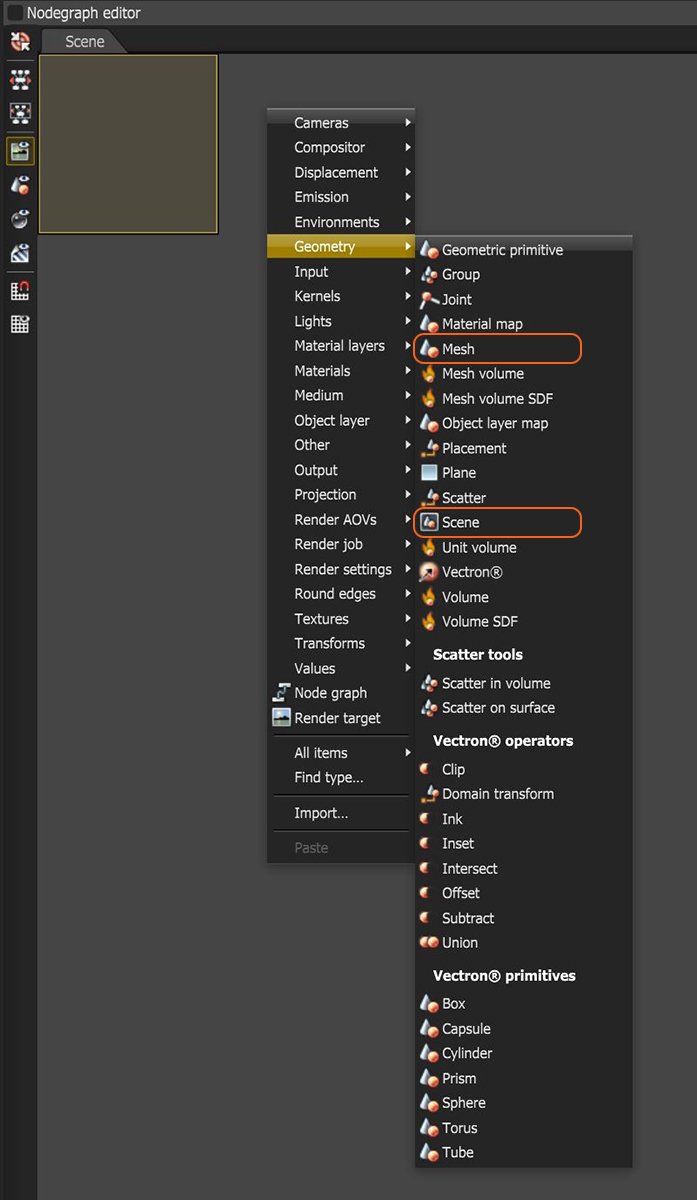
You can import geometry into OctaneRender® by using Mesh or Scene nodes. Before importing, make sure the Mesh is an OBJ file and the Scene is an AlembicAn open format used to bake animated scenes for easy transfer between digital content creation tools., FBX.fbx (Filmbox) is a proprietary file format developed by Kaydara and owned by Autodesk since 2006. It is used to provide interoperability between digital content creation applications. As of Octane 3.07, a scene node will also be available as an FBX file, allowing for quick and easy transport of assets from industry standard DCC applications, or USD file, then right-click anywhere in the Nodegraph Editor, then click Geometry and select either the Mesh or Scene options.
Once you import a scene into OctaneRender, connect it to the Render Target. To combine multiple objects, use the Group node. If you need to reposition an object, connect a Placement node between the object and the Render Target The settings within the Placement node can set the position, and a Mesh node can connect to multiple Placement nodes, each with its own settings, to create many instances of the same object.
To determine how Octane renders OBJ meshes and scenes, you can adjust the settings in the Import tab of Preferences. You can access the Mesh settings by clicking on the Wrench icon in the Node Inspector when you select the Mesh node. Settings for units, smoothing, and subdivision are found in the Import options.

Figure 1: Managing geometry is achieved by right-clicking in the Nodegraph Editor
OctaneRender supports loading FBX, Alembic, and glTF files. These file formats load as a geometry archive, i.e. a Node Graph with lots of stuff inside and providing material and object layer input linkers as well as camera and geometry output linkers.
Although OctaneRender supports bones, it does not support inverse kinematic (IK) animations. This means it is necessary to convert any IK animation to forward kinematic (FK) to make the FBX files work in OctaneRender.
To support FBX and glTF, OctaneRender has support for bone deformations. Character animations can be more lightweight than if the deformed geometry needs to be baked, as in the case with Alembic.
Bone deformations are set up in the respective source 3D modeling applications, and are not editable from the Nodegraph Editor. At this stage, the Bone Deformation node and the Joint node exists for the benefit of the FBX and gITF files, and potential optimizations in the geometry compilation.
There is now native support for USD scene import and USD as the default format in Octane and ORBXThe ORBX file format is the best way to transfer scene files from 3D Authoring software programs that use the Octane Plug-in such as Octane for Maya, Octane for Cinema 4D, or OctaneRender Standalone. This format is more efficient than FBX when working with Octane specific data as it provides a flexible, application independent format. ORBX is a container format that includes all animation data, models, textures etc. that is needed to transfer an Octane scene from one application to another. for scene interchange-ability between DCC plugins and standalone. Multi-render allows Octane to swap to any other rendering engine (including standard Hydra Render Delegates) in seconds. This brings completely new renderers into Octane core, including OTOY Brigade (real time path tracing engine), OTOY AnimeRender, Autodesk Arnold and Cycles.